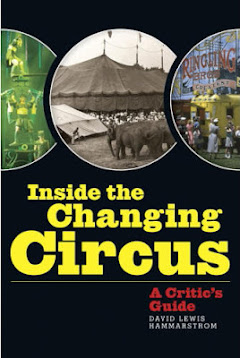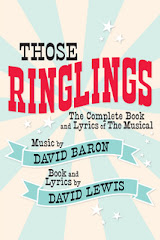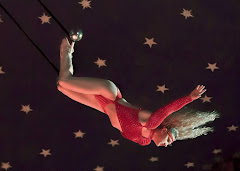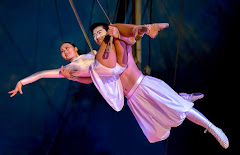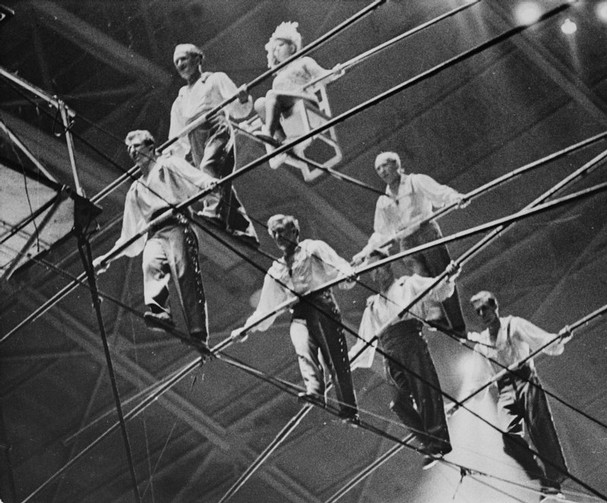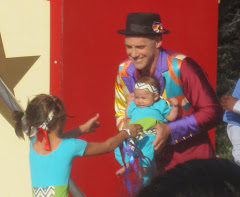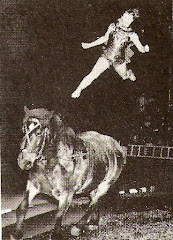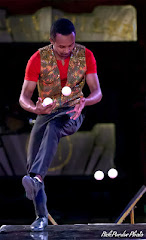Television Review: The Circus
PBS/American Experience
4-hour anthology in 2 parts
Twice seen for this review, October, 2018
.
Although, in real life, P.T. Barnum did not enter the picture until 1871, here he enters it from the get-go, fairly dominating the first two hours of The Circus with his bombastic, perversely amusing ballyhoos, his freaks and fakes, clever humbugs and various exotic animals. The talking heads who wax lyrical about circus artistry -- the consensus seeming to rise on the word “transcendence” -- do not wax lyrical about anything that Mr. Barnum brought to the tent. In fact, he was obviously more a sideshow huckster than ever a circus king
.
Barnum on Broadway, at the Museum: Frank Lentini, above; Jo-Jo, the Dog Faced Boy, below
When producer-writer-director Sharon Grimberg finally gets around to the starting point at Philadelphia in 1793, incredibly, no mention is made of Philip Astley -– an unconscionable insult to the British, who this year are celebrating the 250th anniversary of Astley’s one-ring gift to the world.
Instead, one of the talking heads (name not shown), rhapsodizes over the launch in Philadelphia of a “distinctly American”circus. Nice try. Distinctly American lay decades ahead. The exceptionalism on display at Ricket’s Circus was very British.
Beyond Barnum, whom Grimberg can’t seem to get enough of, she turns her most passionate attention upon a select few big top movers and shakers, telling their compelling stories with a rich array of visual materials at hand. Among the many nuggets, film footage inside the big top during the 1944 Hartford fire is stunning; a clip of Con Colleano dancing on the low wire is pure gold.
The good news is that Adam Forepaugh receives outstanding coverage. So do William Coup and Dan Costello, who talked the retired Prince of Humbug into joining them to take out a new circus, which opened in Brooklyn in 1871, and within a year, was on rails and appearing under a large tent in two rings. Not noted is how Barnum simultaneously rented out the use of his magnetic name, two summers in a row, to a rogue showman, Peggy O’Brien, which gave rivals ad copy ammunition: “Barnum’s Show is Divided! One Half Here, and The Other There. Which Are You Going to See?” The treachery so disgusted Coup and Costello, that the short-lived partnership was soon history. Barnum’s New England lobby may wish to skip this one.
Most impressive of all is James A. Bailey, who joined up with Barnum in 1881 to form — distinctly American — the first three-ring circus. His genius for big top logistics shines through, especially when. in 1897, Barnum having died six years before, he manages to ship the entire show, tents and all, to Europe, where he tours it triumphantly for five years to “almost” constantly packed houses. I question that. Back in the states, now facing a five-brother juggernaut, Bailey’s invincible grip on public favor wanes. Like a man yet to come bearing the initials JRN, he suffers seasons of declining patronage. They all do.
Around about here, we are pulled down into gloom and guilt by the intrusive allusion to animal abuse, which feels like a PETA pop up ad appearing on the screen. In this instance, of how only less than 20% of the animals Barnum and Bailey purchased from other lands allegedly survived the cruel shipping conditions to America. Pretty shocking. There’s also the account of how P.T. wrested away Jumbo (it feels more like a theft) from the British Zoological Society, leaving countless children in tears. I’m siding with the moppets.
Other issues raised concern a display of “uncivilized peoples” in the menagerie and, of course, the freaks. Is the imposition of learned commentary even appropriate? I say no, for these reasons: Imposing modern sensibilities on the circus as it impacted the public over a hundred years ago throws everything out of wack, out of a reality far removed from today’s. Being pulled into the classroom, so to speak, detracts from the experience of watching circus in context of the times. I want the closest thing to what my forebears experienced.
It is worth noting that the recent Ken Burns film on Vietnam, a staggering masterpiece, left a panel of academic historians miffed overs its “deliberate exclusion of professional historians from their 80 talking heads” “We weren’t trying to make arguments.” explained Burns. “ We didn’t have a political agenda..”
Like a bright new sunny day dawning, come the Ringling brothers, who were young and gleamingly handsome on bill poster art, open to new ideas (giving some customers their first look at a movie, inside a special black tent). They paid female performers the same as they paid the men, and they supported the suffrage movement among like-minded women on show They became famous for being by far the most honest-dealing of the lot, although as to the hiring of Pinkerton detectives to monitor the midway for all manner of pick pocketing and card sharkery, curiously, that credit goes here not to the Ringlings, but to Barnum & Bailey! A baffling revelation.
By the time that The Circus reaches the year 1938, John Ringling North barely makes it onto the lot in this lopsided 4-hour anthology – long enough (21 minutes) to come off looking like a talented but inept manager in a final segment that feels fragmentary and rushed. He gets credit for his whimsical elephant ballet and for some rave reviews his upscale brand of circus received, but no mention of the great crowds his eclectic showmanship drew in the best of seasons. He is implicitly linked to gross mismanagement partly blamed for the 1944 Hartford fire that killed 168 people, mostly women and children. The fire, which dominates this section, did not not occur on North’s watch, but on that of his cousin, Robert Ringling. Left unrevealed is the long-simmering enmity between the houses of John and Charles Ringling, and how it erupted into the Ringling family wars of the 1940s, with North eventually prevailing.
North issues a press release announcing that he is closing the show and sending it back to the barn. Alright, yes, he did. And so then ...? I am on the edge of my seat, wondering if, during my first viewing, I missed the part when North announces his plans to open the circus the following spring at Madison Square Garden, as usual, and then take it out on the road playing indoor arenas. No, I did not. Incredibly this key part of the release – so integral to understanding the truth of that last stand under canvas -- is left out. Whatever Grimberg was trying to achieve, it seems clear that evidence was willfully excluded to advance a false reality. One can only speculate what her agenda might be, but certainty it was not to affirm any future for the circus.
Twenty one minutes for John Ringling North, one of the towering creative forces in world circus history. Twenty one minutes for him to look like a loser and vanish. So much for the captivating parade of circus stars from far and wide that he unstintingly offered Americans; for the ingenious seat wagons of Art Concello; the arguably unprecedented costume design brilliance of Miles White; the dazzling midway makeovers of Norman Bel Geddes and then Bill Ballantine; the academy award winning movie by Cecil B. DeMille that captured it all so gloriously. None of that is here. What is here, instead, is the end.
Betty Hutton and Cornel Wilde in The Greatest Show on Earth
All of which amounts to a wholesale evisceration of all that came after Pittsburgh, and I need not go into detail here, other than to make clear, The Greatest Show on Earth continued on for sixty more years. North put it indoors and back in the black, and, ten years later, sold it to the Irvin Feld family.
I can’t help but wondering why so many major contributors to American circus were missing in action during the film’s time frame. To name but a few: Arthur Concello, Antoinette Concello, the Bloomington circus community, then the prime source of leading trapeze acts world-wide, Dan Rice, Miles White, Barbette, Irving J. Polack, Louis Stern (Polack Bros), Gargantua, American Circus Corporation shows, Cole Bros, Sells Bros, Alfred Court, Francis Brunn, Lou Jacobs.
Given the vast terrain of circus history either ignored, short-shrifted or bungled by Grimberg and colleagues, I am left, still, dreaming of the ultimate documentary from Ken burns.






















